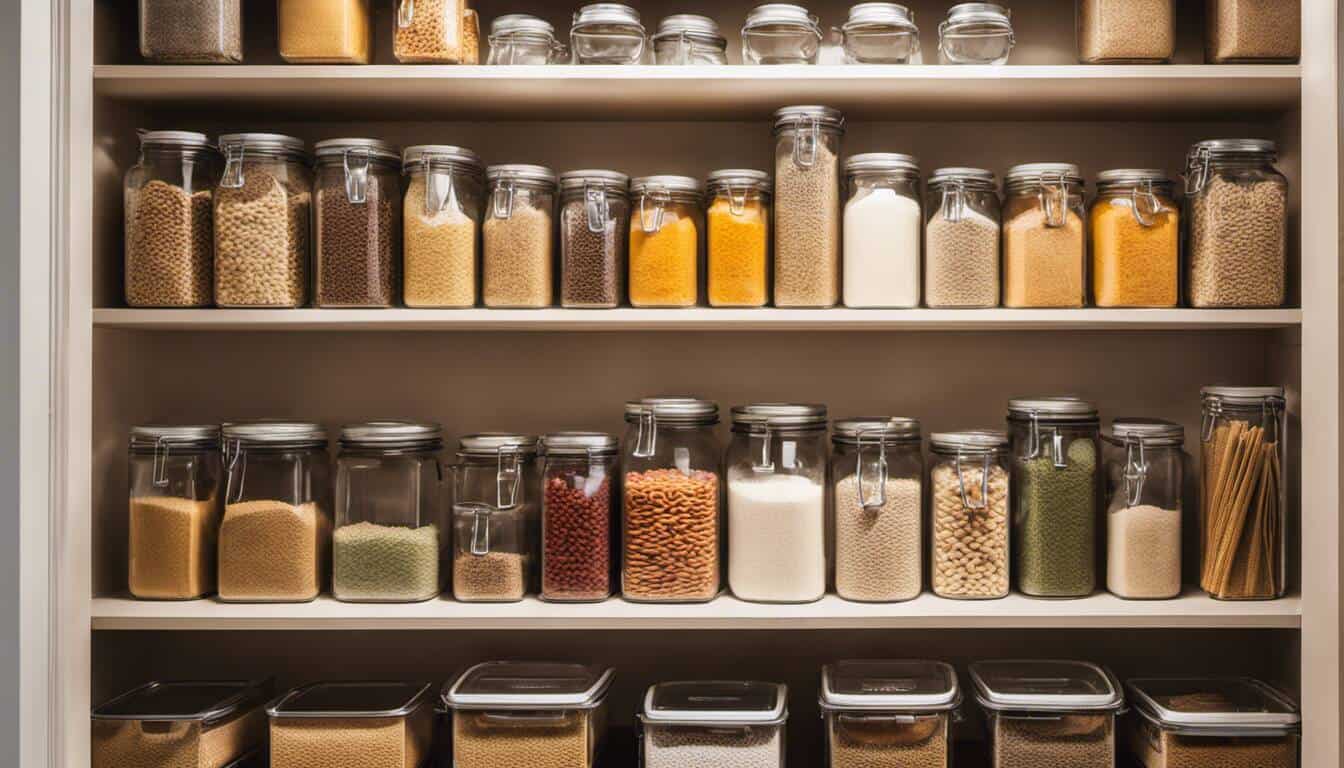Overflowing with jars of pickles past their prime, boxes of cereal from three years ago, and a chaos that says ‘detour’ more than ‘dinner,’ my pantry was far from orderly. I share how I tackled that clutter and turned it into an organized space. These straightforward steps, you’ll transform your pantry from chaos to calm and never lose sight of your favorite seasoning again!
Our “How I Tackled My Cluttered Pantry” article provides practical tips and insights based on a real-life experience of decluttering and organizing a pantry. You will learn about the steps taken, such as sorting items into groups, using storage bins and containers, labeling, and storing less frequently used items on top shelves. You will also gain valuable advice on products that you can use to help organize your pantry better.

“Maintaining a clutter-free pantry goes beyond just an initial cleaning spree. It’s about establishing a system that suits your lifestyle and the type of food items you frequently purchase. Always group similar items together in easily accessible containers to avoid chaos, and adopt the ‘First-In-First-Out’ rule to help keep inventory controlled and fresh. It’s your pantry, a place for inspiration as you cook, so allow it to breathe and become a space you love to visit.”
Bernadette Vogler, Certified Professional Organizer
Identifying Pantry Clutter
Before diving into the organization process, it’s crucial to identify and acknowledge the clutter in your pantry. Take a moment to assess the current state of your pantry and recognize the areas that need improvement. Look out for common signs of pantry clutter, such as expired or unused food items, disorganized shelves, overcrowded spaces, and difficulty in finding what you need. By understanding the extent of the clutter, you can develop an effective plan to tackle the chaos.
For instance, imagine opening your pantry doors only to be met with a jumble of cereal boxes falling out and cans stacked haphazardly on top of each other. This chaotic scene not only makes it difficult to find specific items but also leads to frustration and wasted time.
Grouping & Sorting Food Items
Once you’ve identified the clutter in your pantry, the next step is to start grouping and sorting your food items. This process involves categorizing similar items together to create a more organized and efficient space.
Begin by emptying your pantry shelves completely. As you remove each item, assess its condition and check for expiration dates. Discard any expired or spoiled food immediately. Take this opportunity to declutter by getting rid of items that you no longer use or want.
Next, group similar food items together based on their categories. Create separate piles for baking supplies, canned goods, snacks, condiments, grains, spices, and any other relevant categories that suit your household’s needs. This method allows for easy visibility and accessibility when retrieving items from your pantry.
Category |
Examples |
|---|---|
Baking Supplies |
Flour, sugar, baking powder |
Canned Goods |
Soups, vegetables, fruits |
Snacks |
Chips, crackers, granola bars |
Condiments |
Ketchup, mayonnaise, salad dressings |
Grains |
Rice, pasta, quinoa |
Now that you have successfully identified the clutter in your pantry and grouped your food items into categories, it’s time to explore effective strategies for organizing your pantry to create a functional and visually pleasing space.
Effective Organization Strategies
When it comes to tackling a cluttered pantry, having effective organization strategies in place can make all the difference. It’s essential to approach organization with a plan and consider factors such as visibility, accessibility, and categorization. One strategy is to start by painting and/or decorating the pantry to create a fresh and clean look. Adding removable vinyl accent walls and decals can add a pop of color and make the space more inviting. Another effective strategy is to sort all the food items into groups, such as baking items, larger packaged food, snacks, condiments, etc. This makes it easier to locate specific items and ensures everything has its designated place.
Selecting Space Saving Solutions
Once you have sorted and categorized your pantry items, selecting space-saving solutions is crucial for maximizing storage efficiency. Look for bins and containers that fit the space of your pantry to utilize every inch effectively. Clear or open-top containers are recommended as they allow for easy visibility and access. Utilizing vertical space is also important in smaller pantries. Consider using stackable storage solutions or even installing additional shelves or hanging racks to make use of all available space. For spices and small items, spice racks, door-mounted organizers, or drawer inserts can help keep everything neat and accessible.
Picture this: You are preparing dinner, trying to find a particular spice amidst a sea of bottles in your cluttered pantry. Frustration sets in as you sift through endless jars. By incorporating space-saving solutions like clear bins for categorizing spices or expandable tiered shelving for canned goods, you can transform your pantry into an organized oasis. No more wasted time searching for ingredients – just grab what you need at a glance.
By employing effective organization strategies combined with carefully selected space-saving solutions, you can transform your cluttered pantry into an efficient and visually appealing space. The next crucial aspect to consider is how to optimize the use of containers and shelves.
- To efficiently organize your pantry, categorize items and choose space-saving solutions like clear bins, stackable storage, and spice racks. Utilizing vertical space can also maximize storage, and installing additional shelves or hanging racks may be necessary. By implementing these strategies, you can transform your pantry into an organized and visually appealing space, saving time and reducing frustration when searching for ingredients.
Optimal Use of Containers & Shelves
When it comes to organizing and decluttering your pantry, the efficient use of containers and shelves can make a significant difference. Opt for clear, open-top containers, as they allow for easy visibility of the contents inside. Consider investing in various sizes of bins and jars that fit the space of your pantry. These containers not only keep your items neatly arranged but also protect them from spills or damage. Additionally, utilizing shelves effectively is crucial. Reserve the top shelves for storing items that are not frequently used, such as glassware. This way, you can keep everyday essentials within reach while maximizing vertical space.
Picture this: You open your pantry door and immediately see rows of neatly aligned clear containers, inviting you to explore their organized contents. No more searching through stacks of mismatched packaging! With your baking supplies in one bin, snacks in another, and condiments in labeled jars — everything has its designated home. It’s like having your own mini grocery store right at your fingertips.
By grouping similar items together, you not only save time but also ensure that everything is easily accessible. When it comes to arranging containers and jars on shelves, consider placing frequently used items at eye level for convenience. This makes it effortless to locate ingredients or grab a quick snack without having to search through multiple shelves or drawers.
Now that we have covered the optimal use of containers and shelves let’s move on to another essential aspect of pantry organization: labeling for better organization.
Labeling for Better Organization
Labels play a pivotal role in maintaining an organized pantry. They provide clear guidance for family members or guests who may need to find specific items or assist with restocking groceries correctly. Whether you’re using vinyl labels on jars or adhesive labels on bins, clear and concise labeling helps streamline the organization process.
Consider investing in vinyl jar and bin labels that are both functional and aesthetically pleasing. These labels can be easily applied, removed, and repositioned as needed. A quick glance at a properly labeled jar or bin ensures that you can find the exact spice or ingredient you need without rummaging through multiple containers.
Imagine the satisfaction of locating your favorite seasoning blend by simply scanning the neatly labeled spice jars on your pantry shelf. No more guessing or wasting time searching through unmarked containers! The clear labeling enables everyone in your household to quickly identify and return items to their proper places.
Furthermore, labeling reduces the chances of expiration and food waste. By adding expiration dates to your labels, you’re reminded to use ingredients before they go bad. This helps you maximize the freshness of your pantry items and minimize unnecessary waste.
Now that we have explored the importance of labeling for better organization let’s move on to sustaining an organized pantry.
Sustaining Your Organized Pantry
Congratulations! You’ve successfully tackled the clutter and organized your pantry to perfection. Now comes the crucial step of sustaining that organization to ensure long-term benefits. It’s understandable that maintaining an organized pantry can seem challenging, especially when life gets busy and things get hectic. But fear not, there are several strategies you can implement to keep your pantry in top shape.
One key aspect of sustaining an organized pantry is regular maintenance. Take a few minutes each week or month to reassess and declutter any items that may have accumulated or become disorganized. This will help prevent clutter from building up again over time. Remember, organization is an ongoing process that requires a little effort to maintain.
“I found it helpful to designate a specific day each month for pantry maintenance,” said Sarah, a busy working mom. “It keeps me on track and ensures that everything remains neat and accessible.”
Another strategy is to set up a system for rotating your food items. When unpacking groceries, make sure to move older items to the front while placing new purchases towards the back. This way, you’ll use up older products first, reducing the chances of expiration dates sneaking up on you.
To better visualize this concept, consider the following example:
Before Grocery Shopping |
After Grocery Shopping |
|---|---|
Older products at the front |
New purchases at the back |
Recently purchased items in back |
Move older items forward |
Think of it like arranging books on a shelf – you want to put recently read books towards the back and bring forward ones you haven’t read yet.
Furthermore, maintaining clear and visible labels on your containers and bins can significantly contribute to sustainability. When everyone in your household can easily identify where items belong, they are more likely to put things back in their designated places. Utilize the vinyl labels and markers we recommended earlier to ensure clarity and consistency.
Lastly, make it a habit to regularly check for expired or unused items. We all have those forgotten cans or spices hidden somewhere in the pantry. By periodically reviewing your inventory and discarding anything past its prime or no longer needed, you’ll prevent clutter from accumulating and free up valuable space for new purchases.
With these strategies in mind, sustaining your organized pantry becomes an achievable goal rather than an overwhelming task.
- According to a survey conducted by National Association of Productivity and Organizing Professionals in 2020, approximately 54% respondents noted their kitchen and pantry as the most disorganized space in their home.
- A study by BJ Fogg at Stanford University revealed that people who maintain organized kitchens are 3 times more likely to eat healthier, leading to better physical health.
- An IKEA “Life at Home” report highlighted that globally, 25% of people feel their storage areas like pantries need an overhaul for being too chaotic or disorganised.





Using labeled containers for grouping alike items has been my go-to strategy, making it a lot easier not just to locate stuff but also monitor what supplies may be running low.
In my experience, a lazy Susan can work miracles in a crowded pantry, making it quite easy to access those sneaky little spice jars that tend to hide at the back.
Couldn’t agree more with you, Gertrude! I’ve been using lazy Susans for years and they are indeed game changers for pantry organization. However, one hack to take this to another level is to categorize your items before placing them on the turntable. For example, I have separate ones for my baking ingredients, spices, and preserves which saves me so much time when I am in the middle of cooking.
I have a dedicated box in my pantry just for baking ingredients – it’s my personal ‘bakery in a box’ as I like to call it, makes whipping up a batch of cookies or a cake much more streamlined!
Actually, left to my own devices, I have taken a page from office filing protocols and decided to sort my pantry items by frequency of use, besides just categories. That approach really helps when you need those special exotic spices that you only use once in a while – less rummaging around involved!